Evaluation of Munch and Move Intervention: A Health Promotion Report
VerifiedAdded on 2023/06/12
|17
|4498
|411
Report
AI Summary
This report provides an analysis of the Munch and Move intervention, a health promotion initiative developed by NSW Health to address child obesity by promoting healthy eating, physical activity, and reduced screen time among children under the age of 5. The intervention focuses on training early childhood professionals to implement fun and play-based approaches in early childhood care services and educational settings. The report examines the intervention in light of health promotion frameworks, social determinants of health, systems thinking, health equity, and environmental sustainability. It highlights the program's key principles, including daily physical activity, healthy drink and snack choices, breastfeeding encouragement, increased fruit and vegetable consumption, and reduced screen time. The report also compares the intervention to the Commission on Social Determinants of Health and discusses its alignment with determinants of health for the 21st century, emphasizing the importance of social investment and addressing health challenges related to lifestyle and obesity.
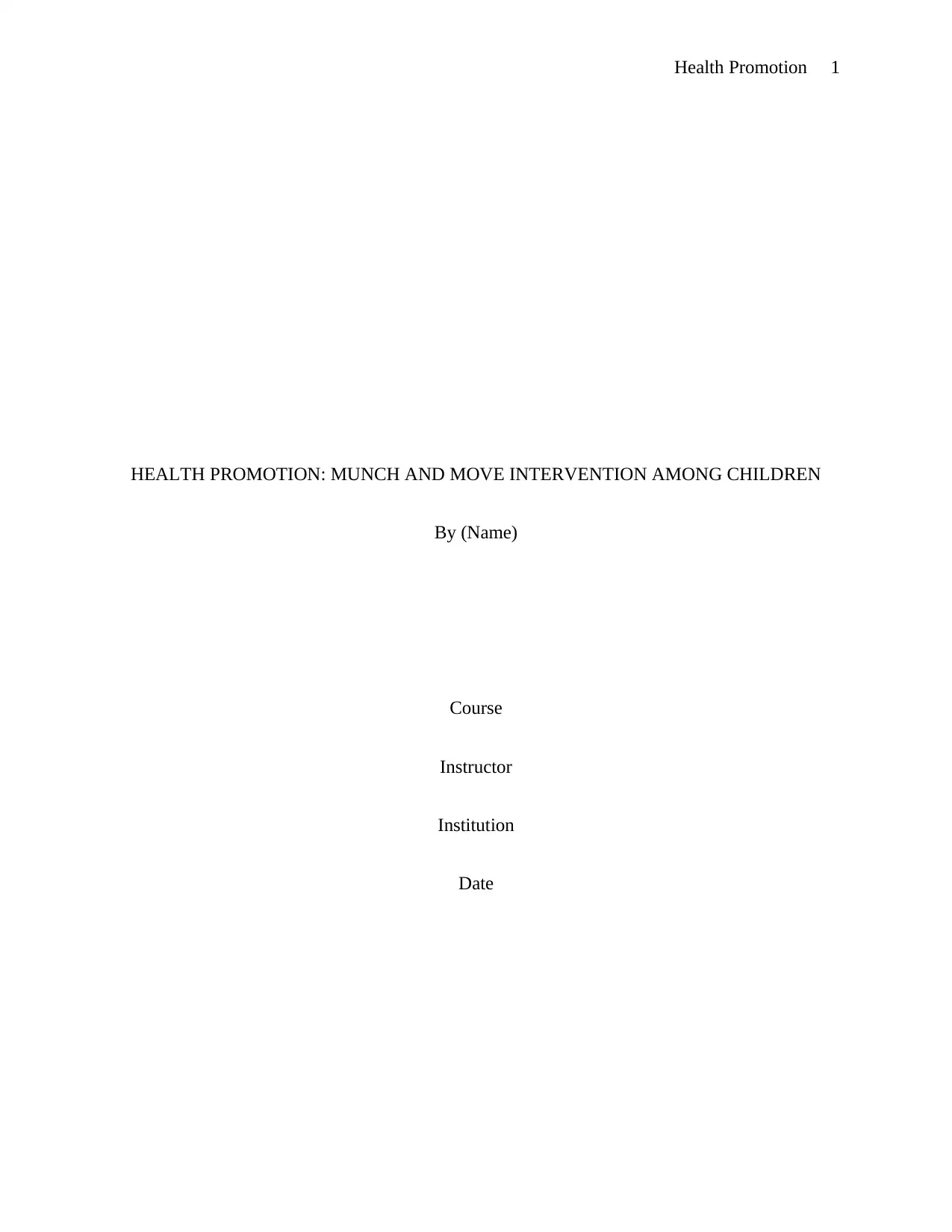
Health Promotion 1
HEALTH PROMOTION: MUNCH AND MOVE INTERVENTION AMONG CHILDREN
By (Name)
Course
Instructor
Institution
Date
HEALTH PROMOTION: MUNCH AND MOVE INTERVENTION AMONG CHILDREN
By (Name)
Course
Instructor
Institution
Date
Paraphrase This Document
Need a fresh take? Get an instant paraphrase of this document with our AI Paraphraser
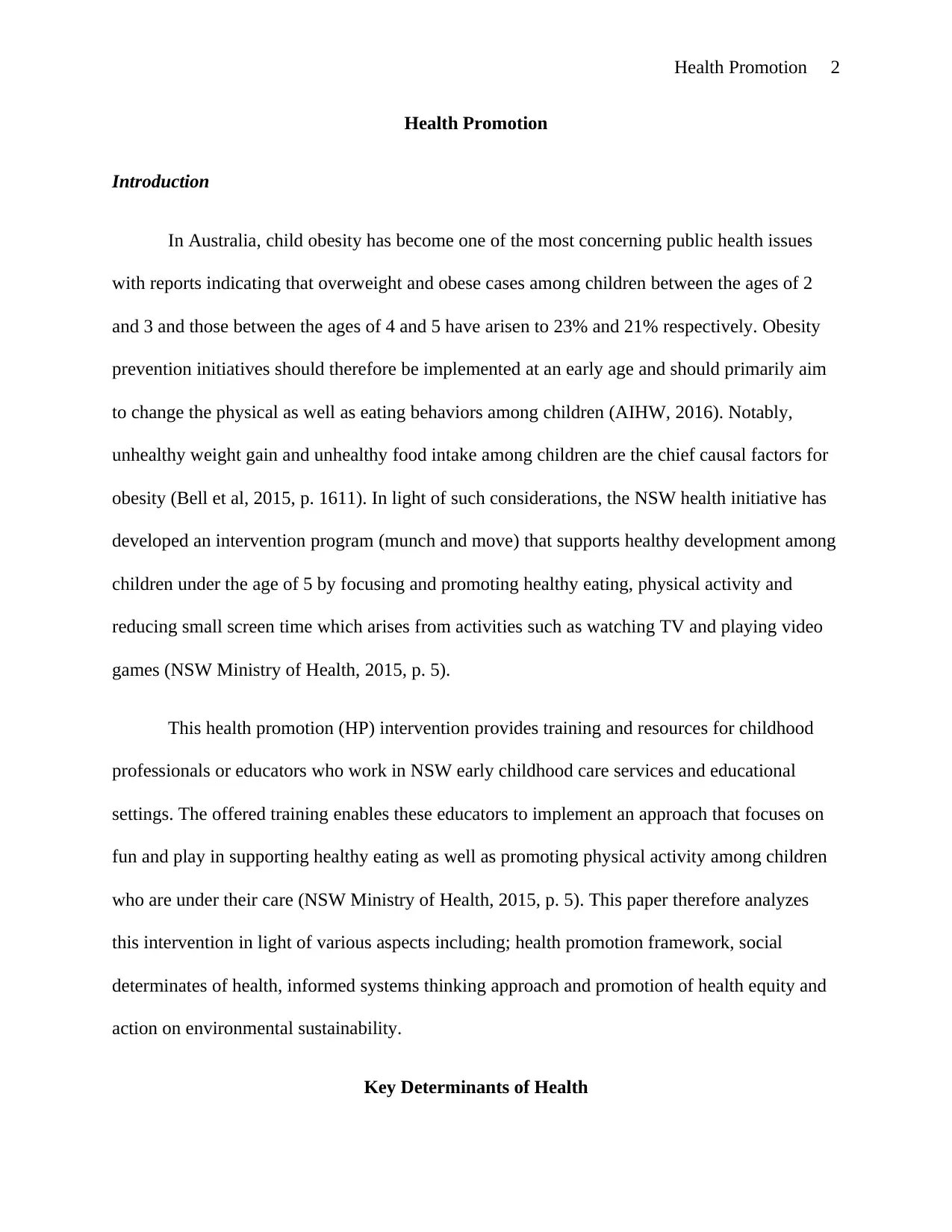
Health Promotion 2
Health Promotion
Introduction
In Australia, child obesity has become one of the most concerning public health issues
with reports indicating that overweight and obese cases among children between the ages of 2
and 3 and those between the ages of 4 and 5 have arisen to 23% and 21% respectively. Obesity
prevention initiatives should therefore be implemented at an early age and should primarily aim
to change the physical as well as eating behaviors among children (AIHW, 2016). Notably,
unhealthy weight gain and unhealthy food intake among children are the chief causal factors for
obesity (Bell et al, 2015, p. 1611). In light of such considerations, the NSW health initiative has
developed an intervention program (munch and move) that supports healthy development among
children under the age of 5 by focusing and promoting healthy eating, physical activity and
reducing small screen time which arises from activities such as watching TV and playing video
games (NSW Ministry of Health, 2015, p. 5).
This health promotion (HP) intervention provides training and resources for childhood
professionals or educators who work in NSW early childhood care services and educational
settings. The offered training enables these educators to implement an approach that focuses on
fun and play in supporting healthy eating as well as promoting physical activity among children
who are under their care (NSW Ministry of Health, 2015, p. 5). This paper therefore analyzes
this intervention in light of various aspects including; health promotion framework, social
determinates of health, informed systems thinking approach and promotion of health equity and
action on environmental sustainability.
Key Determinants of Health
Health Promotion
Introduction
In Australia, child obesity has become one of the most concerning public health issues
with reports indicating that overweight and obese cases among children between the ages of 2
and 3 and those between the ages of 4 and 5 have arisen to 23% and 21% respectively. Obesity
prevention initiatives should therefore be implemented at an early age and should primarily aim
to change the physical as well as eating behaviors among children (AIHW, 2016). Notably,
unhealthy weight gain and unhealthy food intake among children are the chief causal factors for
obesity (Bell et al, 2015, p. 1611). In light of such considerations, the NSW health initiative has
developed an intervention program (munch and move) that supports healthy development among
children under the age of 5 by focusing and promoting healthy eating, physical activity and
reducing small screen time which arises from activities such as watching TV and playing video
games (NSW Ministry of Health, 2015, p. 5).
This health promotion (HP) intervention provides training and resources for childhood
professionals or educators who work in NSW early childhood care services and educational
settings. The offered training enables these educators to implement an approach that focuses on
fun and play in supporting healthy eating as well as promoting physical activity among children
who are under their care (NSW Ministry of Health, 2015, p. 5). This paper therefore analyzes
this intervention in light of various aspects including; health promotion framework, social
determinates of health, informed systems thinking approach and promotion of health equity and
action on environmental sustainability.
Key Determinants of Health
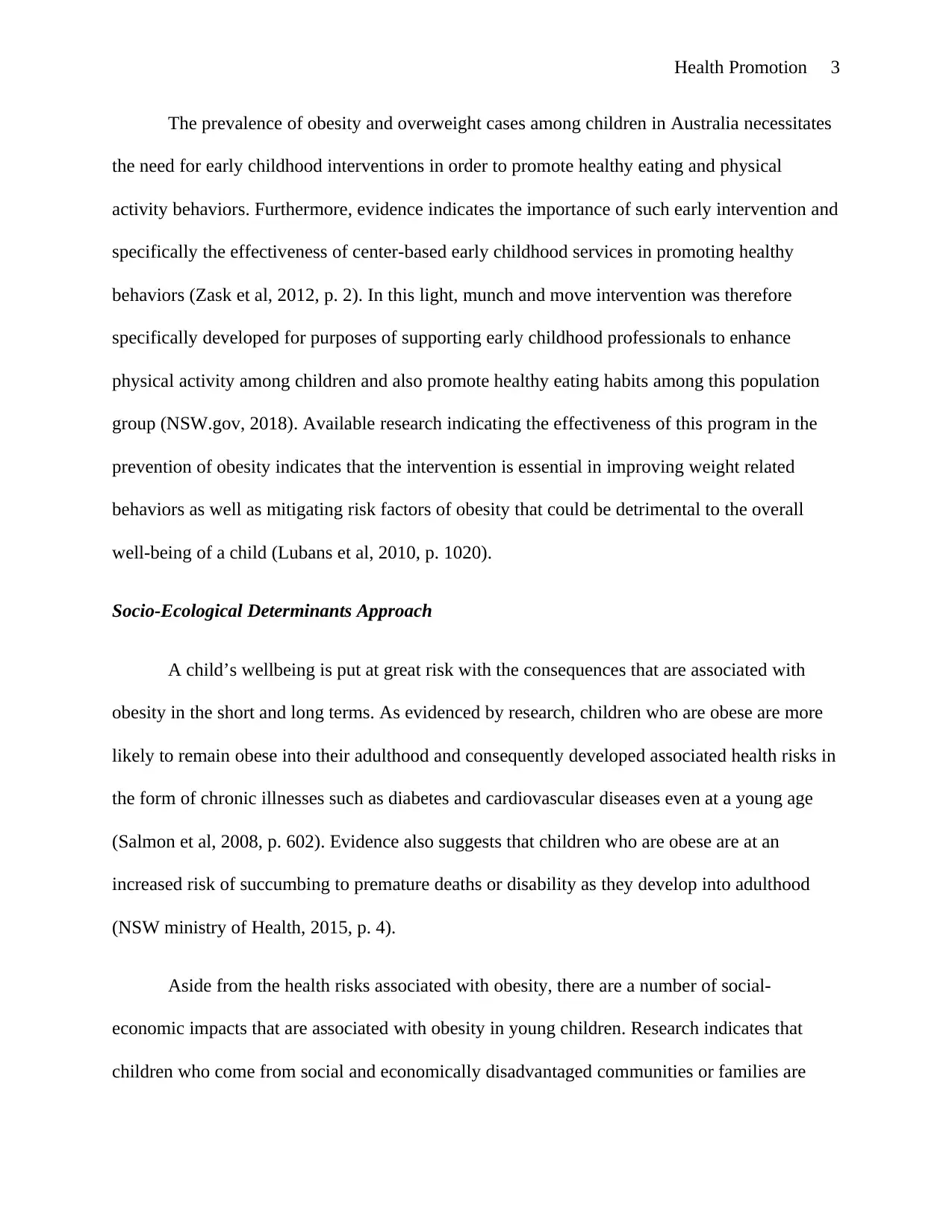
Health Promotion 3
The prevalence of obesity and overweight cases among children in Australia necessitates
the need for early childhood interventions in order to promote healthy eating and physical
activity behaviors. Furthermore, evidence indicates the importance of such early intervention and
specifically the effectiveness of center-based early childhood services in promoting healthy
behaviors (Zask et al, 2012, p. 2). In this light, munch and move intervention was therefore
specifically developed for purposes of supporting early childhood professionals to enhance
physical activity among children and also promote healthy eating habits among this population
group (NSW.gov, 2018). Available research indicating the effectiveness of this program in the
prevention of obesity indicates that the intervention is essential in improving weight related
behaviors as well as mitigating risk factors of obesity that could be detrimental to the overall
well-being of a child (Lubans et al, 2010, p. 1020).
Socio-Ecological Determinants Approach
A child’s wellbeing is put at great risk with the consequences that are associated with
obesity in the short and long terms. As evidenced by research, children who are obese are more
likely to remain obese into their adulthood and consequently developed associated health risks in
the form of chronic illnesses such as diabetes and cardiovascular diseases even at a young age
(Salmon et al, 2008, p. 602). Evidence also suggests that children who are obese are at an
increased risk of succumbing to premature deaths or disability as they develop into adulthood
(NSW ministry of Health, 2015, p. 4).
Aside from the health risks associated with obesity, there are a number of social-
economic impacts that are associated with obesity in young children. Research indicates that
children who come from social and economically disadvantaged communities or families are
The prevalence of obesity and overweight cases among children in Australia necessitates
the need for early childhood interventions in order to promote healthy eating and physical
activity behaviors. Furthermore, evidence indicates the importance of such early intervention and
specifically the effectiveness of center-based early childhood services in promoting healthy
behaviors (Zask et al, 2012, p. 2). In this light, munch and move intervention was therefore
specifically developed for purposes of supporting early childhood professionals to enhance
physical activity among children and also promote healthy eating habits among this population
group (NSW.gov, 2018). Available research indicating the effectiveness of this program in the
prevention of obesity indicates that the intervention is essential in improving weight related
behaviors as well as mitigating risk factors of obesity that could be detrimental to the overall
well-being of a child (Lubans et al, 2010, p. 1020).
Socio-Ecological Determinants Approach
A child’s wellbeing is put at great risk with the consequences that are associated with
obesity in the short and long terms. As evidenced by research, children who are obese are more
likely to remain obese into their adulthood and consequently developed associated health risks in
the form of chronic illnesses such as diabetes and cardiovascular diseases even at a young age
(Salmon et al, 2008, p. 602). Evidence also suggests that children who are obese are at an
increased risk of succumbing to premature deaths or disability as they develop into adulthood
(NSW ministry of Health, 2015, p. 4).
Aside from the health risks associated with obesity, there are a number of social-
economic impacts that are associated with obesity in young children. Research indicates that
children who come from social and economically disadvantaged communities or families are
⊘ This is a preview!⊘
Do you want full access?
Subscribe today to unlock all pages.

Trusted by 1+ million students worldwide
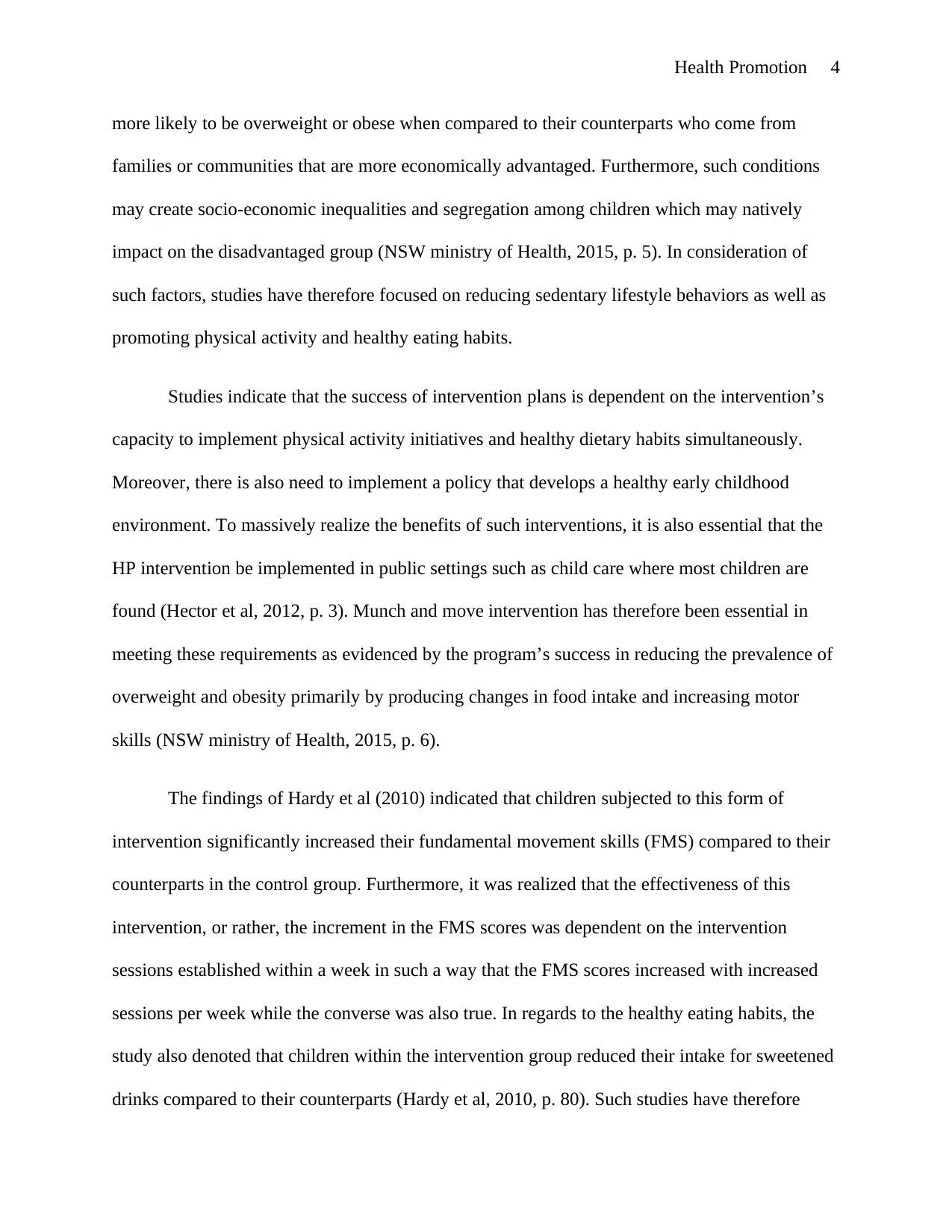
Health Promotion 4
more likely to be overweight or obese when compared to their counterparts who come from
families or communities that are more economically advantaged. Furthermore, such conditions
may create socio-economic inequalities and segregation among children which may natively
impact on the disadvantaged group (NSW ministry of Health, 2015, p. 5). In consideration of
such factors, studies have therefore focused on reducing sedentary lifestyle behaviors as well as
promoting physical activity and healthy eating habits.
Studies indicate that the success of intervention plans is dependent on the intervention’s
capacity to implement physical activity initiatives and healthy dietary habits simultaneously.
Moreover, there is also need to implement a policy that develops a healthy early childhood
environment. To massively realize the benefits of such interventions, it is also essential that the
HP intervention be implemented in public settings such as child care where most children are
found (Hector et al, 2012, p. 3). Munch and move intervention has therefore been essential in
meeting these requirements as evidenced by the program’s success in reducing the prevalence of
overweight and obesity primarily by producing changes in food intake and increasing motor
skills (NSW ministry of Health, 2015, p. 6).
The findings of Hardy et al (2010) indicated that children subjected to this form of
intervention significantly increased their fundamental movement skills (FMS) compared to their
counterparts in the control group. Furthermore, it was realized that the effectiveness of this
intervention, or rather, the increment in the FMS scores was dependent on the intervention
sessions established within a week in such a way that the FMS scores increased with increased
sessions per week while the converse was also true. In regards to the healthy eating habits, the
study also denoted that children within the intervention group reduced their intake for sweetened
drinks compared to their counterparts (Hardy et al, 2010, p. 80). Such studies have therefore
more likely to be overweight or obese when compared to their counterparts who come from
families or communities that are more economically advantaged. Furthermore, such conditions
may create socio-economic inequalities and segregation among children which may natively
impact on the disadvantaged group (NSW ministry of Health, 2015, p. 5). In consideration of
such factors, studies have therefore focused on reducing sedentary lifestyle behaviors as well as
promoting physical activity and healthy eating habits.
Studies indicate that the success of intervention plans is dependent on the intervention’s
capacity to implement physical activity initiatives and healthy dietary habits simultaneously.
Moreover, there is also need to implement a policy that develops a healthy early childhood
environment. To massively realize the benefits of such interventions, it is also essential that the
HP intervention be implemented in public settings such as child care where most children are
found (Hector et al, 2012, p. 3). Munch and move intervention has therefore been essential in
meeting these requirements as evidenced by the program’s success in reducing the prevalence of
overweight and obesity primarily by producing changes in food intake and increasing motor
skills (NSW ministry of Health, 2015, p. 6).
The findings of Hardy et al (2010) indicated that children subjected to this form of
intervention significantly increased their fundamental movement skills (FMS) compared to their
counterparts in the control group. Furthermore, it was realized that the effectiveness of this
intervention, or rather, the increment in the FMS scores was dependent on the intervention
sessions established within a week in such a way that the FMS scores increased with increased
sessions per week while the converse was also true. In regards to the healthy eating habits, the
study also denoted that children within the intervention group reduced their intake for sweetened
drinks compared to their counterparts (Hardy et al, 2010, p. 80). Such studies have therefore
Paraphrase This Document
Need a fresh take? Get an instant paraphrase of this document with our AI Paraphraser
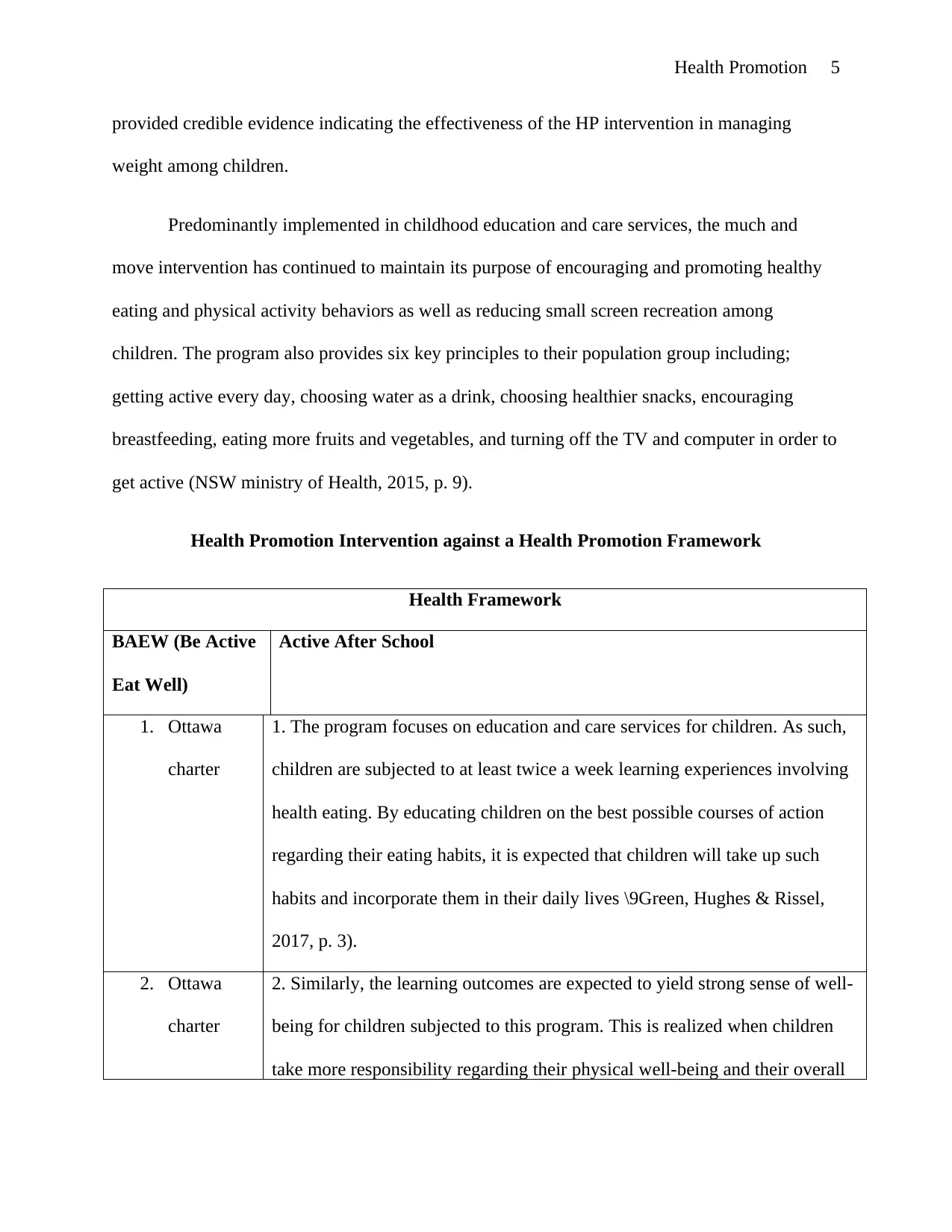
Health Promotion 5
provided credible evidence indicating the effectiveness of the HP intervention in managing
weight among children.
Predominantly implemented in childhood education and care services, the much and
move intervention has continued to maintain its purpose of encouraging and promoting healthy
eating and physical activity behaviors as well as reducing small screen recreation among
children. The program also provides six key principles to their population group including;
getting active every day, choosing water as a drink, choosing healthier snacks, encouraging
breastfeeding, eating more fruits and vegetables, and turning off the TV and computer in order to
get active (NSW ministry of Health, 2015, p. 9).
Health Promotion Intervention against a Health Promotion Framework
Health Framework
BAEW (Be Active
Eat Well)
Active After School
1. Ottawa
charter
1. The program focuses on education and care services for children. As such,
children are subjected to at least twice a week learning experiences involving
health eating. By educating children on the best possible courses of action
regarding their eating habits, it is expected that children will take up such
habits and incorporate them in their daily lives \9Green, Hughes & Rissel,
2017, p. 3).
2. Ottawa
charter
2. Similarly, the learning outcomes are expected to yield strong sense of well-
being for children subjected to this program. This is realized when children
take more responsibility regarding their physical well-being and their overall
provided credible evidence indicating the effectiveness of the HP intervention in managing
weight among children.
Predominantly implemented in childhood education and care services, the much and
move intervention has continued to maintain its purpose of encouraging and promoting healthy
eating and physical activity behaviors as well as reducing small screen recreation among
children. The program also provides six key principles to their population group including;
getting active every day, choosing water as a drink, choosing healthier snacks, encouraging
breastfeeding, eating more fruits and vegetables, and turning off the TV and computer in order to
get active (NSW ministry of Health, 2015, p. 9).
Health Promotion Intervention against a Health Promotion Framework
Health Framework
BAEW (Be Active
Eat Well)
Active After School
1. Ottawa
charter
1. The program focuses on education and care services for children. As such,
children are subjected to at least twice a week learning experiences involving
health eating. By educating children on the best possible courses of action
regarding their eating habits, it is expected that children will take up such
habits and incorporate them in their daily lives \9Green, Hughes & Rissel,
2017, p. 3).
2. Ottawa
charter
2. Similarly, the learning outcomes are expected to yield strong sense of well-
being for children subjected to this program. This is realized when children
take more responsibility regarding their physical well-being and their overall
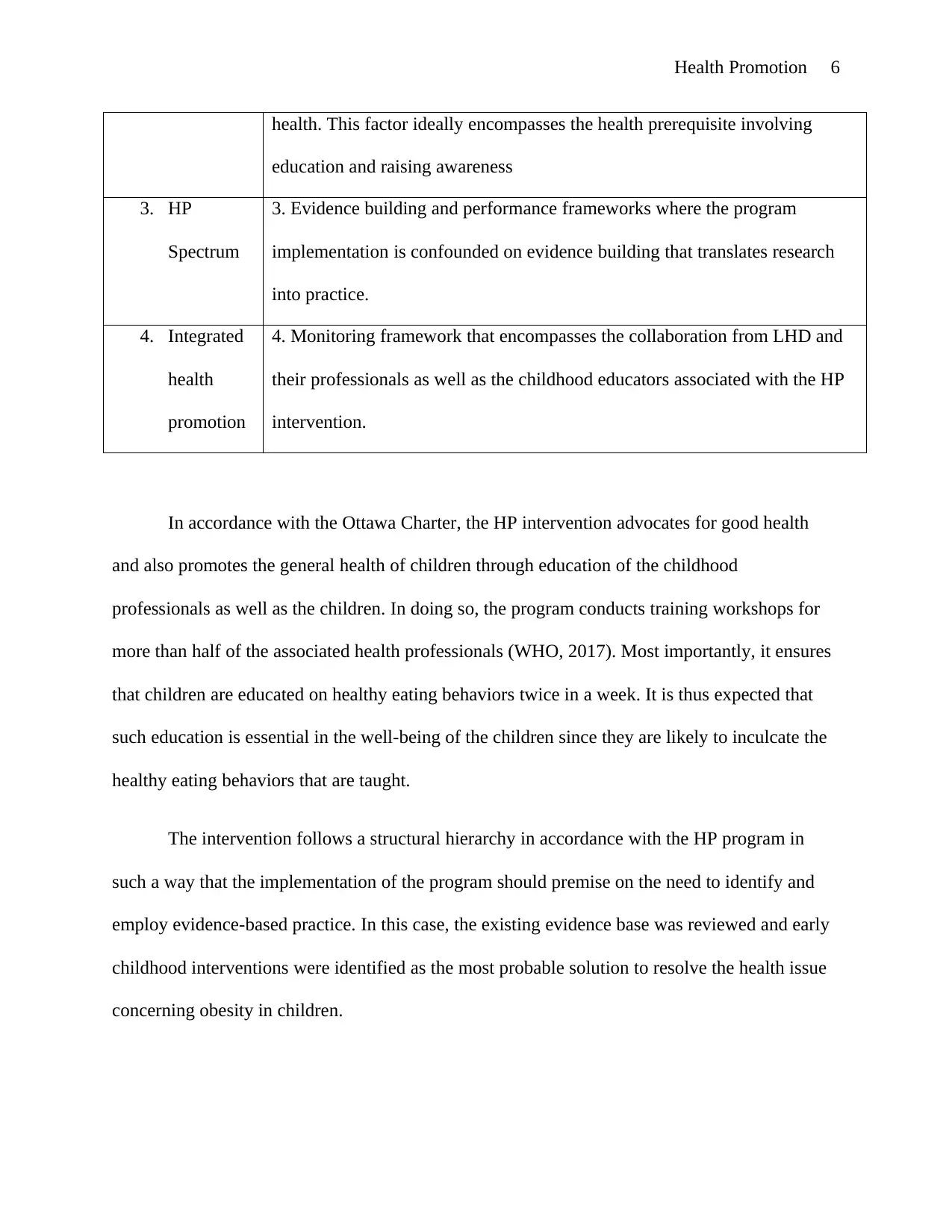
Health Promotion 6
health. This factor ideally encompasses the health prerequisite involving
education and raising awareness
3. HP
Spectrum
3. Evidence building and performance frameworks where the program
implementation is confounded on evidence building that translates research
into practice.
4. Integrated
health
promotion
4. Monitoring framework that encompasses the collaboration from LHD and
their professionals as well as the childhood educators associated with the HP
intervention.
In accordance with the Ottawa Charter, the HP intervention advocates for good health
and also promotes the general health of children through education of the childhood
professionals as well as the children. In doing so, the program conducts training workshops for
more than half of the associated health professionals (WHO, 2017). Most importantly, it ensures
that children are educated on healthy eating behaviors twice in a week. It is thus expected that
such education is essential in the well-being of the children since they are likely to inculcate the
healthy eating behaviors that are taught.
The intervention follows a structural hierarchy in accordance with the HP program in
such a way that the implementation of the program should premise on the need to identify and
employ evidence-based practice. In this case, the existing evidence base was reviewed and early
childhood interventions were identified as the most probable solution to resolve the health issue
concerning obesity in children.
health. This factor ideally encompasses the health prerequisite involving
education and raising awareness
3. HP
Spectrum
3. Evidence building and performance frameworks where the program
implementation is confounded on evidence building that translates research
into practice.
4. Integrated
health
promotion
4. Monitoring framework that encompasses the collaboration from LHD and
their professionals as well as the childhood educators associated with the HP
intervention.
In accordance with the Ottawa Charter, the HP intervention advocates for good health
and also promotes the general health of children through education of the childhood
professionals as well as the children. In doing so, the program conducts training workshops for
more than half of the associated health professionals (WHO, 2017). Most importantly, it ensures
that children are educated on healthy eating behaviors twice in a week. It is thus expected that
such education is essential in the well-being of the children since they are likely to inculcate the
healthy eating behaviors that are taught.
The intervention follows a structural hierarchy in accordance with the HP program in
such a way that the implementation of the program should premise on the need to identify and
employ evidence-based practice. In this case, the existing evidence base was reviewed and early
childhood interventions were identified as the most probable solution to resolve the health issue
concerning obesity in children.
⊘ This is a preview!⊘
Do you want full access?
Subscribe today to unlock all pages.

Trusted by 1+ million students worldwide
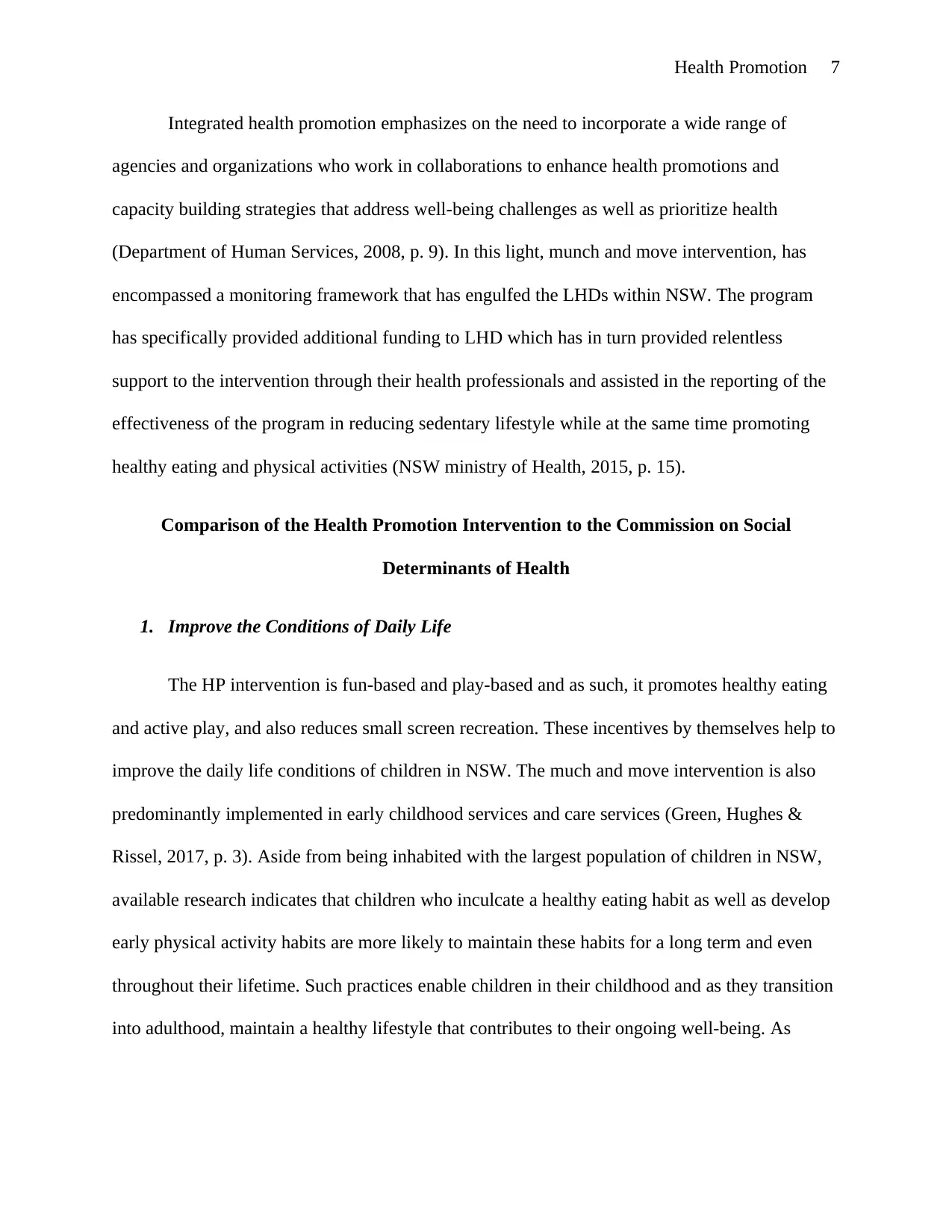
Health Promotion 7
Integrated health promotion emphasizes on the need to incorporate a wide range of
agencies and organizations who work in collaborations to enhance health promotions and
capacity building strategies that address well-being challenges as well as prioritize health
(Department of Human Services, 2008, p. 9). In this light, munch and move intervention, has
encompassed a monitoring framework that has engulfed the LHDs within NSW. The program
has specifically provided additional funding to LHD which has in turn provided relentless
support to the intervention through their health professionals and assisted in the reporting of the
effectiveness of the program in reducing sedentary lifestyle while at the same time promoting
healthy eating and physical activities (NSW ministry of Health, 2015, p. 15).
Comparison of the Health Promotion Intervention to the Commission on Social
Determinants of Health
1. Improve the Conditions of Daily Life
The HP intervention is fun-based and play-based and as such, it promotes healthy eating
and active play, and also reduces small screen recreation. These incentives by themselves help to
improve the daily life conditions of children in NSW. The much and move intervention is also
predominantly implemented in early childhood services and care services (Green, Hughes &
Rissel, 2017, p. 3). Aside from being inhabited with the largest population of children in NSW,
available research indicates that children who inculcate a healthy eating habit as well as develop
early physical activity habits are more likely to maintain these habits for a long term and even
throughout their lifetime. Such practices enable children in their childhood and as they transition
into adulthood, maintain a healthy lifestyle that contributes to their ongoing well-being. As
Integrated health promotion emphasizes on the need to incorporate a wide range of
agencies and organizations who work in collaborations to enhance health promotions and
capacity building strategies that address well-being challenges as well as prioritize health
(Department of Human Services, 2008, p. 9). In this light, munch and move intervention, has
encompassed a monitoring framework that has engulfed the LHDs within NSW. The program
has specifically provided additional funding to LHD which has in turn provided relentless
support to the intervention through their health professionals and assisted in the reporting of the
effectiveness of the program in reducing sedentary lifestyle while at the same time promoting
healthy eating and physical activities (NSW ministry of Health, 2015, p. 15).
Comparison of the Health Promotion Intervention to the Commission on Social
Determinants of Health
1. Improve the Conditions of Daily Life
The HP intervention is fun-based and play-based and as such, it promotes healthy eating
and active play, and also reduces small screen recreation. These incentives by themselves help to
improve the daily life conditions of children in NSW. The much and move intervention is also
predominantly implemented in early childhood services and care services (Green, Hughes &
Rissel, 2017, p. 3). Aside from being inhabited with the largest population of children in NSW,
available research indicates that children who inculcate a healthy eating habit as well as develop
early physical activity habits are more likely to maintain these habits for a long term and even
throughout their lifetime. Such practices enable children in their childhood and as they transition
into adulthood, maintain a healthy lifestyle that contributes to their ongoing well-being. As
Paraphrase This Document
Need a fresh take? Get an instant paraphrase of this document with our AI Paraphraser
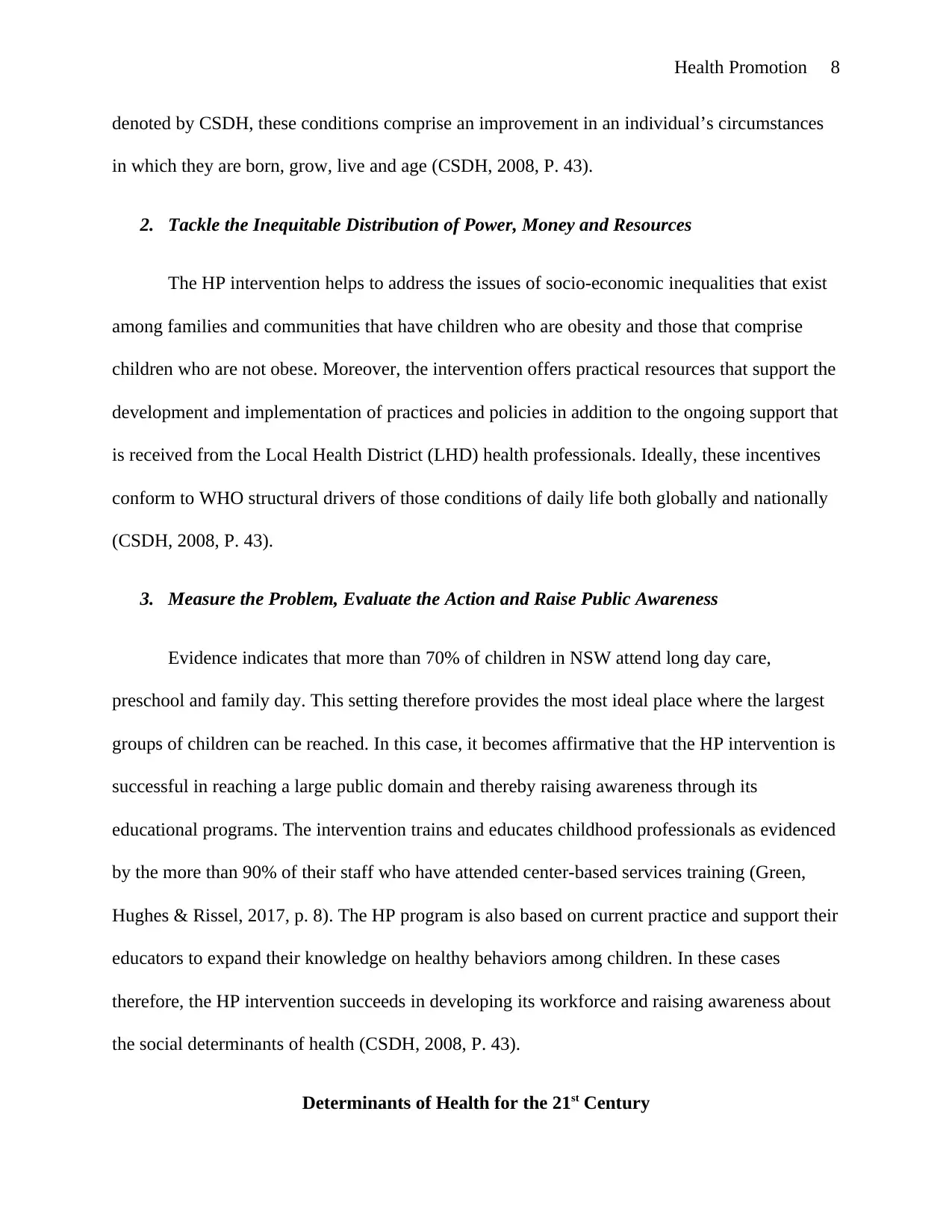
Health Promotion 8
denoted by CSDH, these conditions comprise an improvement in an individual’s circumstances
in which they are born, grow, live and age (CSDH, 2008, P. 43).
2. Tackle the Inequitable Distribution of Power, Money and Resources
The HP intervention helps to address the issues of socio-economic inequalities that exist
among families and communities that have children who are obesity and those that comprise
children who are not obese. Moreover, the intervention offers practical resources that support the
development and implementation of practices and policies in addition to the ongoing support that
is received from the Local Health District (LHD) health professionals. Ideally, these incentives
conform to WHO structural drivers of those conditions of daily life both globally and nationally
(CSDH, 2008, P. 43).
3. Measure the Problem, Evaluate the Action and Raise Public Awareness
Evidence indicates that more than 70% of children in NSW attend long day care,
preschool and family day. This setting therefore provides the most ideal place where the largest
groups of children can be reached. In this case, it becomes affirmative that the HP intervention is
successful in reaching a large public domain and thereby raising awareness through its
educational programs. The intervention trains and educates childhood professionals as evidenced
by the more than 90% of their staff who have attended center-based services training (Green,
Hughes & Rissel, 2017, p. 8). The HP program is also based on current practice and support their
educators to expand their knowledge on healthy behaviors among children. In these cases
therefore, the HP intervention succeeds in developing its workforce and raising awareness about
the social determinants of health (CSDH, 2008, P. 43).
Determinants of Health for the 21st Century
denoted by CSDH, these conditions comprise an improvement in an individual’s circumstances
in which they are born, grow, live and age (CSDH, 2008, P. 43).
2. Tackle the Inequitable Distribution of Power, Money and Resources
The HP intervention helps to address the issues of socio-economic inequalities that exist
among families and communities that have children who are obesity and those that comprise
children who are not obese. Moreover, the intervention offers practical resources that support the
development and implementation of practices and policies in addition to the ongoing support that
is received from the Local Health District (LHD) health professionals. Ideally, these incentives
conform to WHO structural drivers of those conditions of daily life both globally and nationally
(CSDH, 2008, P. 43).
3. Measure the Problem, Evaluate the Action and Raise Public Awareness
Evidence indicates that more than 70% of children in NSW attend long day care,
preschool and family day. This setting therefore provides the most ideal place where the largest
groups of children can be reached. In this case, it becomes affirmative that the HP intervention is
successful in reaching a large public domain and thereby raising awareness through its
educational programs. The intervention trains and educates childhood professionals as evidenced
by the more than 90% of their staff who have attended center-based services training (Green,
Hughes & Rissel, 2017, p. 8). The HP program is also based on current practice and support their
educators to expand their knowledge on healthy behaviors among children. In these cases
therefore, the HP intervention succeeds in developing its workforce and raising awareness about
the social determinants of health (CSDH, 2008, P. 43).
Determinants of Health for the 21st Century
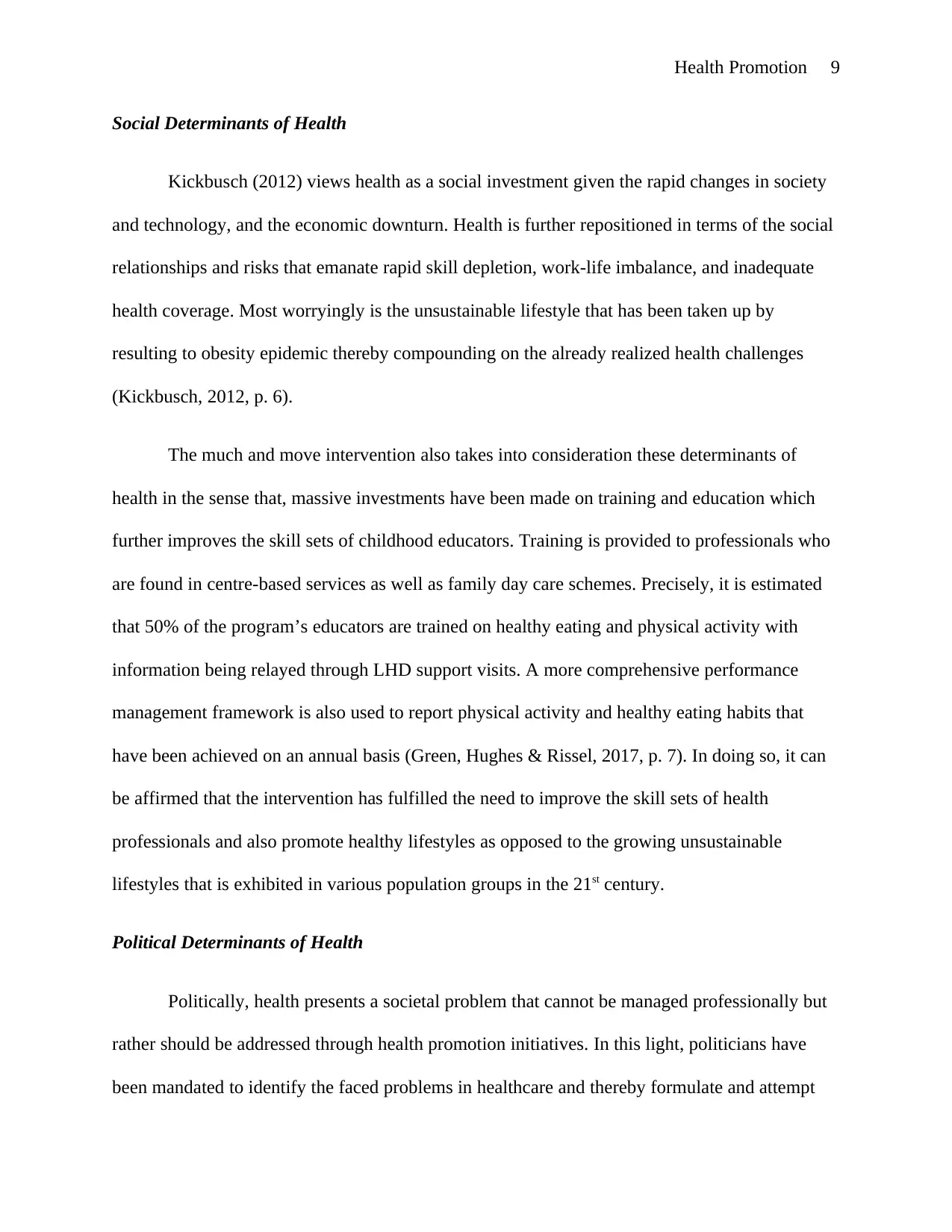
Health Promotion 9
Social Determinants of Health
Kickbusch (2012) views health as a social investment given the rapid changes in society
and technology, and the economic downturn. Health is further repositioned in terms of the social
relationships and risks that emanate rapid skill depletion, work-life imbalance, and inadequate
health coverage. Most worryingly is the unsustainable lifestyle that has been taken up by
resulting to obesity epidemic thereby compounding on the already realized health challenges
(Kickbusch, 2012, p. 6).
The much and move intervention also takes into consideration these determinants of
health in the sense that, massive investments have been made on training and education which
further improves the skill sets of childhood educators. Training is provided to professionals who
are found in centre-based services as well as family day care schemes. Precisely, it is estimated
that 50% of the program’s educators are trained on healthy eating and physical activity with
information being relayed through LHD support visits. A more comprehensive performance
management framework is also used to report physical activity and healthy eating habits that
have been achieved on an annual basis (Green, Hughes & Rissel, 2017, p. 7). In doing so, it can
be affirmed that the intervention has fulfilled the need to improve the skill sets of health
professionals and also promote healthy lifestyles as opposed to the growing unsustainable
lifestyles that is exhibited in various population groups in the 21st century.
Political Determinants of Health
Politically, health presents a societal problem that cannot be managed professionally but
rather should be addressed through health promotion initiatives. In this light, politicians have
been mandated to identify the faced problems in healthcare and thereby formulate and attempt
Social Determinants of Health
Kickbusch (2012) views health as a social investment given the rapid changes in society
and technology, and the economic downturn. Health is further repositioned in terms of the social
relationships and risks that emanate rapid skill depletion, work-life imbalance, and inadequate
health coverage. Most worryingly is the unsustainable lifestyle that has been taken up by
resulting to obesity epidemic thereby compounding on the already realized health challenges
(Kickbusch, 2012, p. 6).
The much and move intervention also takes into consideration these determinants of
health in the sense that, massive investments have been made on training and education which
further improves the skill sets of childhood educators. Training is provided to professionals who
are found in centre-based services as well as family day care schemes. Precisely, it is estimated
that 50% of the program’s educators are trained on healthy eating and physical activity with
information being relayed through LHD support visits. A more comprehensive performance
management framework is also used to report physical activity and healthy eating habits that
have been achieved on an annual basis (Green, Hughes & Rissel, 2017, p. 7). In doing so, it can
be affirmed that the intervention has fulfilled the need to improve the skill sets of health
professionals and also promote healthy lifestyles as opposed to the growing unsustainable
lifestyles that is exhibited in various population groups in the 21st century.
Political Determinants of Health
Politically, health presents a societal problem that cannot be managed professionally but
rather should be addressed through health promotion initiatives. In this light, politicians have
been mandated to identify the faced problems in healthcare and thereby formulate and attempt
⊘ This is a preview!⊘
Do you want full access?
Subscribe today to unlock all pages.

Trusted by 1+ million students worldwide
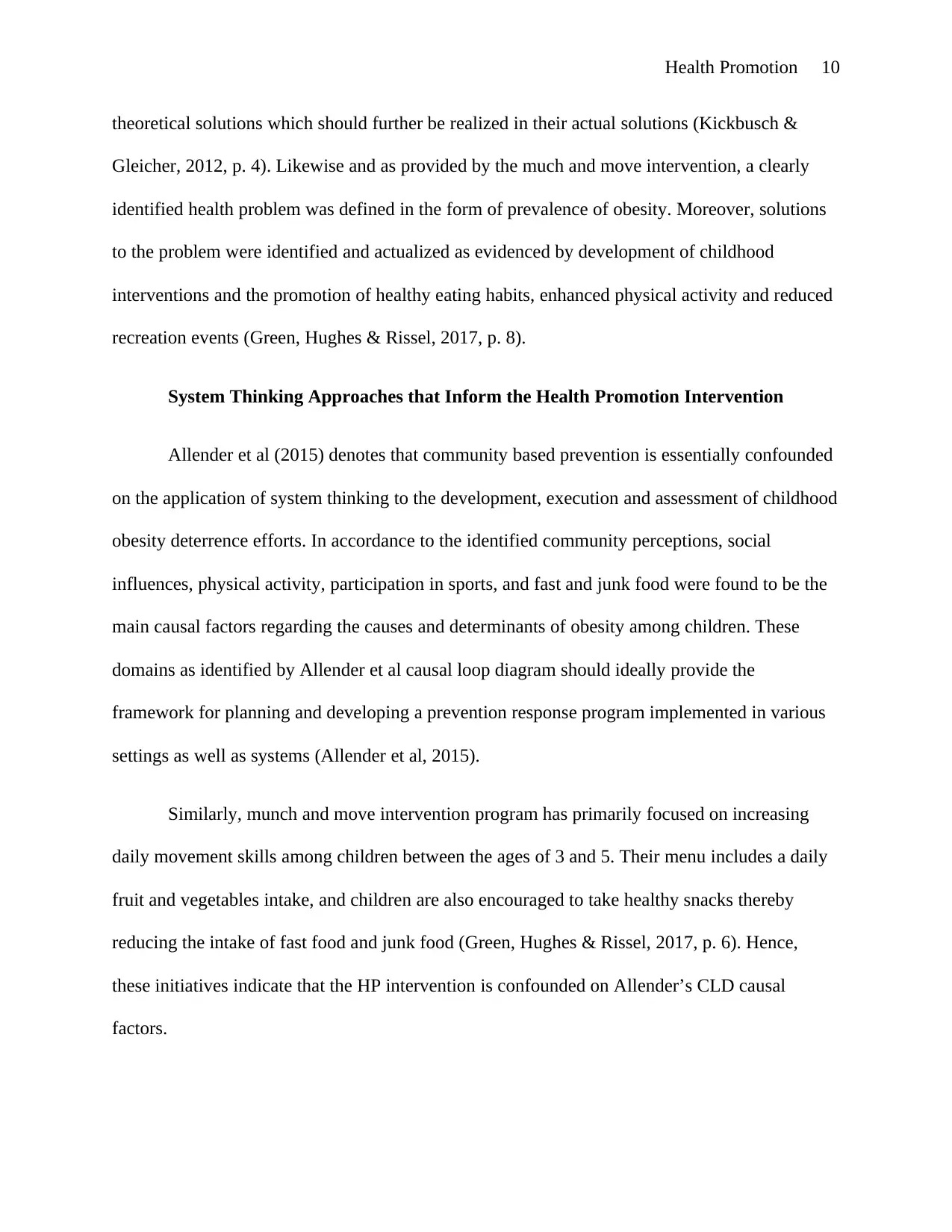
Health Promotion 10
theoretical solutions which should further be realized in their actual solutions (Kickbusch &
Gleicher, 2012, p. 4). Likewise and as provided by the much and move intervention, a clearly
identified health problem was defined in the form of prevalence of obesity. Moreover, solutions
to the problem were identified and actualized as evidenced by development of childhood
interventions and the promotion of healthy eating habits, enhanced physical activity and reduced
recreation events (Green, Hughes & Rissel, 2017, p. 8).
System Thinking Approaches that Inform the Health Promotion Intervention
Allender et al (2015) denotes that community based prevention is essentially confounded
on the application of system thinking to the development, execution and assessment of childhood
obesity deterrence efforts. In accordance to the identified community perceptions, social
influences, physical activity, participation in sports, and fast and junk food were found to be the
main causal factors regarding the causes and determinants of obesity among children. These
domains as identified by Allender et al causal loop diagram should ideally provide the
framework for planning and developing a prevention response program implemented in various
settings as well as systems (Allender et al, 2015).
Similarly, munch and move intervention program has primarily focused on increasing
daily movement skills among children between the ages of 3 and 5. Their menu includes a daily
fruit and vegetables intake, and children are also encouraged to take healthy snacks thereby
reducing the intake of fast food and junk food (Green, Hughes & Rissel, 2017, p. 6). Hence,
these initiatives indicate that the HP intervention is confounded on Allender’s CLD causal
factors.
theoretical solutions which should further be realized in their actual solutions (Kickbusch &
Gleicher, 2012, p. 4). Likewise and as provided by the much and move intervention, a clearly
identified health problem was defined in the form of prevalence of obesity. Moreover, solutions
to the problem were identified and actualized as evidenced by development of childhood
interventions and the promotion of healthy eating habits, enhanced physical activity and reduced
recreation events (Green, Hughes & Rissel, 2017, p. 8).
System Thinking Approaches that Inform the Health Promotion Intervention
Allender et al (2015) denotes that community based prevention is essentially confounded
on the application of system thinking to the development, execution and assessment of childhood
obesity deterrence efforts. In accordance to the identified community perceptions, social
influences, physical activity, participation in sports, and fast and junk food were found to be the
main causal factors regarding the causes and determinants of obesity among children. These
domains as identified by Allender et al causal loop diagram should ideally provide the
framework for planning and developing a prevention response program implemented in various
settings as well as systems (Allender et al, 2015).
Similarly, munch and move intervention program has primarily focused on increasing
daily movement skills among children between the ages of 3 and 5. Their menu includes a daily
fruit and vegetables intake, and children are also encouraged to take healthy snacks thereby
reducing the intake of fast food and junk food (Green, Hughes & Rissel, 2017, p. 6). Hence,
these initiatives indicate that the HP intervention is confounded on Allender’s CLD causal
factors.
Paraphrase This Document
Need a fresh take? Get an instant paraphrase of this document with our AI Paraphraser

Health Promotion 11
Allender et al (2015) also used the causal loop diagrams (CLD) to visually represent the
factors that affected energy balance among individuals. In this process, it was realized that the
complexity of the factors affecting the energy balances among individuals encompassed more
than 100 variables that either directly or indirectly influenced the energy balances (Allender et al,
2015). In light of this, the systems thinking approach to the prevention of obesity should engage
the complexity of the causal factors through policy settings that are individual-based.
The munch and move intervention has mainly achieved this provision through the
initiation of written food policy as well as written policy on physical activity and small screen
recreation to support healthy eating and physical activity habits among children (NSW Ministry
of Health, 2015). In addition, the much and move intervention is aligned with Allender’s systems
approach by ensuring that it is process driven where the intervention activities have primarily
focused on increasing community participation as well as fostering ownership and capacity
(Carey et al, 2015).
The HP intervention is also informed by the systems approach developed by Bloch et al
(2014). In this case, the much and move intervention is a super setting approach applicable in the
community as well as preschools and in which diverse and valuable resources are effectively
utilized while local and social interactions through engagement in physical or daily fundamental
movement skills are primarily used as the drivers of change (Bloch et al, 2014).
Assessment of How the HP Intervention Promotes Health Equity or Action on
Environmental Sustainability
Baum & Fisher (2010) outline the importance of developing a modern model that
incorporates the need for economic development and growth in order to meet the objective of
Allender et al (2015) also used the causal loop diagrams (CLD) to visually represent the
factors that affected energy balance among individuals. In this process, it was realized that the
complexity of the factors affecting the energy balances among individuals encompassed more
than 100 variables that either directly or indirectly influenced the energy balances (Allender et al,
2015). In light of this, the systems thinking approach to the prevention of obesity should engage
the complexity of the causal factors through policy settings that are individual-based.
The munch and move intervention has mainly achieved this provision through the
initiation of written food policy as well as written policy on physical activity and small screen
recreation to support healthy eating and physical activity habits among children (NSW Ministry
of Health, 2015). In addition, the much and move intervention is aligned with Allender’s systems
approach by ensuring that it is process driven where the intervention activities have primarily
focused on increasing community participation as well as fostering ownership and capacity
(Carey et al, 2015).
The HP intervention is also informed by the systems approach developed by Bloch et al
(2014). In this case, the much and move intervention is a super setting approach applicable in the
community as well as preschools and in which diverse and valuable resources are effectively
utilized while local and social interactions through engagement in physical or daily fundamental
movement skills are primarily used as the drivers of change (Bloch et al, 2014).
Assessment of How the HP Intervention Promotes Health Equity or Action on
Environmental Sustainability
Baum & Fisher (2010) outline the importance of developing a modern model that
incorporates the need for economic development and growth in order to meet the objective of
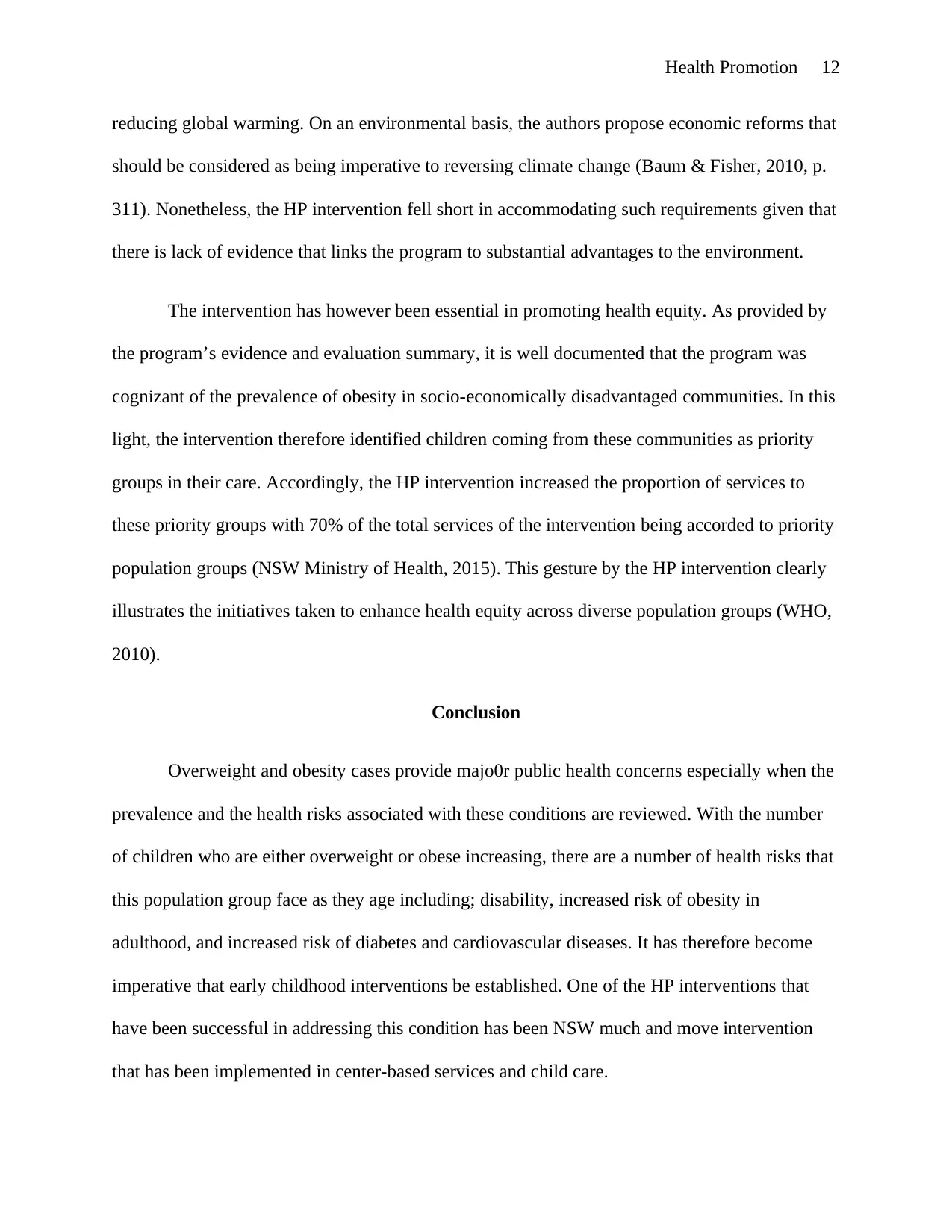
Health Promotion 12
reducing global warming. On an environmental basis, the authors propose economic reforms that
should be considered as being imperative to reversing climate change (Baum & Fisher, 2010, p.
311). Nonetheless, the HP intervention fell short in accommodating such requirements given that
there is lack of evidence that links the program to substantial advantages to the environment.
The intervention has however been essential in promoting health equity. As provided by
the program’s evidence and evaluation summary, it is well documented that the program was
cognizant of the prevalence of obesity in socio-economically disadvantaged communities. In this
light, the intervention therefore identified children coming from these communities as priority
groups in their care. Accordingly, the HP intervention increased the proportion of services to
these priority groups with 70% of the total services of the intervention being accorded to priority
population groups (NSW Ministry of Health, 2015). This gesture by the HP intervention clearly
illustrates the initiatives taken to enhance health equity across diverse population groups (WHO,
2010).
Conclusion
Overweight and obesity cases provide majo0r public health concerns especially when the
prevalence and the health risks associated with these conditions are reviewed. With the number
of children who are either overweight or obese increasing, there are a number of health risks that
this population group face as they age including; disability, increased risk of obesity in
adulthood, and increased risk of diabetes and cardiovascular diseases. It has therefore become
imperative that early childhood interventions be established. One of the HP interventions that
have been successful in addressing this condition has been NSW much and move intervention
that has been implemented in center-based services and child care.
reducing global warming. On an environmental basis, the authors propose economic reforms that
should be considered as being imperative to reversing climate change (Baum & Fisher, 2010, p.
311). Nonetheless, the HP intervention fell short in accommodating such requirements given that
there is lack of evidence that links the program to substantial advantages to the environment.
The intervention has however been essential in promoting health equity. As provided by
the program’s evidence and evaluation summary, it is well documented that the program was
cognizant of the prevalence of obesity in socio-economically disadvantaged communities. In this
light, the intervention therefore identified children coming from these communities as priority
groups in their care. Accordingly, the HP intervention increased the proportion of services to
these priority groups with 70% of the total services of the intervention being accorded to priority
population groups (NSW Ministry of Health, 2015). This gesture by the HP intervention clearly
illustrates the initiatives taken to enhance health equity across diverse population groups (WHO,
2010).
Conclusion
Overweight and obesity cases provide majo0r public health concerns especially when the
prevalence and the health risks associated with these conditions are reviewed. With the number
of children who are either overweight or obese increasing, there are a number of health risks that
this population group face as they age including; disability, increased risk of obesity in
adulthood, and increased risk of diabetes and cardiovascular diseases. It has therefore become
imperative that early childhood interventions be established. One of the HP interventions that
have been successful in addressing this condition has been NSW much and move intervention
that has been implemented in center-based services and child care.
⊘ This is a preview!⊘
Do you want full access?
Subscribe today to unlock all pages.

Trusted by 1+ million students worldwide
1 out of 17
Related Documents
Your All-in-One AI-Powered Toolkit for Academic Success.
+13062052269
info@desklib.com
Available 24*7 on WhatsApp / Email
![[object Object]](/_next/static/media/star-bottom.7253800d.svg)
Unlock your academic potential
Copyright © 2020–2025 A2Z Services. All Rights Reserved. Developed and managed by ZUCOL.





